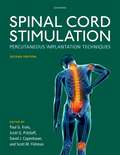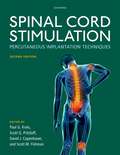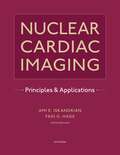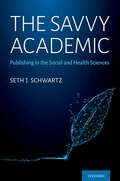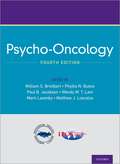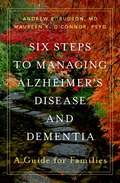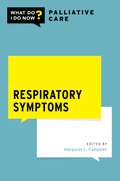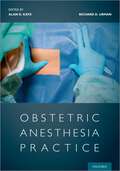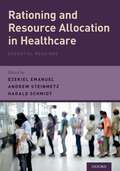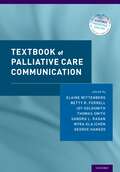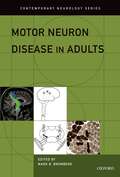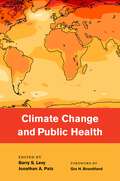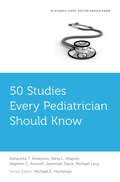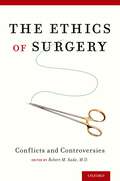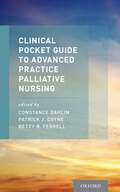- Table View
- List View
Spinal Cord Stimulation: Percutaneous Implantation Techniques
Neuromodulation therapies such as spinal cord, dorsal root ganglion, and peripheral nerve stimulation are used to treat chronic pain syndromes such as intractable back pain, diabetic neuropathy, spinal radiculopathies, and complex regional pain syndrome. Since the publication of the first edition over a decade ago, there has been unprecedented progress in understanding neuromodulation and technological advances in clinical applications. Spinal Cord Stimulation is intended as an essential guide to the clinical fundamentals required for safe and effective implantation of neuromodulation devices. Implantation of these devices is performed by physicians from various disciplines, requiring a multidisciplinary skill set that presents a challenge for surgical and non-surgical pain practitioners alike. This authoritative resource integrates the basic multidisciplinary information necessary for understanding spinal cord stimulation, dorsal root ganglion (DRG), and peripheral nerve stimulation (PNS) with up-to-date implantation techniques for clinicians to use in their daily practice. It also features updated advice for appropriate medical decision making, patient education, safe use of radiation, and managing adverse events, with new chapters dedicated toward DRG stimulation and PNS.
Spinal Cord Stimulation: Percutaneous Implantation Techniques
by Paul G. Kreis, Scott G. Pritzlaff, David J. Copenhaver, and Scott M. FishmanNeuromodulation therapies such as spinal cord, dorsal root ganglion, and peripheral nerve stimulation are used to treat chronic pain syndromes such as intractable back pain, diabetic neuropathy, spinal radiculopathies, and complex regional pain syndrome. Since the publication of the first edition over a decade ago, there has been unprecedented progress in understanding neuromodulation and technological advances in clinical applications. Spinal Cord Stimulation is intended as an essential guide to the clinical fundamentals required for safe and effective implantation of neuromodulation devices. Implantation of these devices is performed by physicians from various disciplines, requiring a multidisciplinary skill set that presents a challenge for surgical and non-surgical pain practitioners alike. This authoritative resource integrates the basic multidisciplinary information necessary for understanding spinal cord stimulation, dorsal root ganglion (DRG), and peripheral nerve stimulation (PNS) with up-to-date implantation techniques for clinicians to use in their daily practice. It also features updated advice for appropriate medical decision making, patient education, safe use of radiation, and managing adverse events, with new chapters dedicated toward DRG stimulation and PNS.
Nuclear Cardiac Imaging: Principles and Applications
Nuclear cardiac imaging refers to cardiac radiological diagnostic techniques performed with the aid of radiopharmaceuticals, which are perfused into the myocardium as markers. These imaging studies provide a wide range of information about the heart, including the contractility of the heart, the amount of blood supply to the heart and whether parts of the heart muscle are alive or dead. This is essential information for cardiologists, and nuclear imaging has become an increasingly important part of the cardiologist's armamentarium. Chapters in Nuclear Cardiac Imaging cover historical, technical and physiological considerations, diagnosis and prognosis, conditions other than Coronary Artery Disease (CAD), advanced cardiac imaging, and challenges and opportunities. New to the sixth edition are key point summaries at the start of each chapter, clinical cases with videos, and a question and answer chapter on practical issues. This volume is ideal for nuclear cardiologists in training and nuclear clinicians alike who are searching for quick answers to important clinical and technical questions.
Nuclear Cardiac Imaging: Principles and Applications
by Ami E. Iskandrian and Fadi G. HageNuclear cardiac imaging refers to cardiac radiological diagnostic techniques performed with the aid of radiopharmaceuticals, which are perfused into the myocardium as markers. These imaging studies provide a wide range of information about the heart, including the contractility of the heart, the amount of blood supply to the heart and whether parts of the heart muscle are alive or dead. This is essential information for cardiologists, and nuclear imaging has become an increasingly important part of the cardiologist's armamentarium. Chapters in Nuclear Cardiac Imaging cover historical, technical and physiological considerations, diagnosis and prognosis, conditions other than Coronary Artery Disease (CAD), advanced cardiac imaging, and challenges and opportunities. New to the sixth edition are key point summaries at the start of each chapter, clinical cases with videos, and a question and answer chapter on practical issues. This volume is ideal for nuclear cardiologists in training and nuclear clinicians alike who are searching for quick answers to important clinical and technical questions.
The Savvy Academic: Publishing in the Social and Health Sciences
by Seth J. SchwartzThis approachable guide meets health and social sciences scholars at their level--either as a reference text or as an enchanting but practical read--and walks them through each stage of their academic publishing journey. Drawing on a wealth of examples from his own experience mentoring others and publishing 300+ articles, Dr. Schwartz engages early, mid-, and senior-level professionals as well as graduate students and postdoctoral fellows alike, to demystify each stage of the writing and publishing process. Employing a reader-friendly, accessible voice, Dr. Schwartz's style captivates readers across disciplines, with a refreshing, can-do perspective. Before diving in, the author relates his own personal story in scholarly publishing, inviting all academics to unlock the high-impact writer within. The next set of chapters tackle the nuts and bolts of the academic publishing process, with basics such as topic selection, data analysis for publication, writing preparation, drafting and editing manuscripts, and journals submissions. The book advances into more innovative topics that can be simultaneously intimidating and rewarding, including recruiting and collaborating with coauthors, developing a network, navigating the peer review process, publishing nonempirical papers, getting creative with rejected manuscripts, foraying into Open Access and fee-based publishing, and even how to publish a book or book chapter. Designed as a digital mentor, The Savvy Academic is the ultimate tool for students, fellows, and scholarly professionals of a broad range of experiences in the health and social sciences who are looking to launch or elevate their scholarly publication career.
The Savvy Academic: Publishing in the Social and Health Sciences
by Seth J. SchwartzThis approachable guide meets health and social sciences scholars at their level--either as a reference text or as an enchanting but practical read--and walks them through each stage of their academic publishing journey. Drawing on a wealth of examples from his own experience mentoring others and publishing 300+ articles, Dr. Schwartz engages early, mid-, and senior-level professionals as well as graduate students and postdoctoral fellows alike, to demystify each stage of the writing and publishing process. Employing a reader-friendly, accessible voice, Dr. Schwartz's style captivates readers across disciplines, with a refreshing, can-do perspective. Before diving in, the author relates his own personal story in scholarly publishing, inviting all academics to unlock the high-impact writer within. The next set of chapters tackle the nuts and bolts of the academic publishing process, with basics such as topic selection, data analysis for publication, writing preparation, drafting and editing manuscripts, and journals submissions. The book advances into more innovative topics that can be simultaneously intimidating and rewarding, including recruiting and collaborating with coauthors, developing a network, navigating the peer review process, publishing nonempirical papers, getting creative with rejected manuscripts, foraying into Open Access and fee-based publishing, and even how to publish a book or book chapter. Designed as a digital mentor, The Savvy Academic is the ultimate tool for students, fellows, and scholarly professionals of a broad range of experiences in the health and social sciences who are looking to launch or elevate their scholarly publication career.
Almost Over: Aging, Dying, Dead
by F. M. KammIn Almost Over, F. M. Kamm presents a wide-ranging philosophical discussion of the moral, legal, and medical issues related to aging, dying, and death. She begins by considering different views about whether and why death is bad for the person who dies and what these views imply about the death of humanity. She then considers whether there are conditions under which it might make sense to deliberately bring a person's death about, given the processes of aging and dying that precede it. In the opinion of some it is not only serious illness but ordinary aging that may give rise to this question and Kamm pays particular attention to the various ways in which aging could affect the distribution of "goods" and "bads" in a particular life. Specifically, she considers how the limitations and changes due to aging and the dying process affect meaning in one's life, and whether the absence of meaning affects the reasonableness of not resisting or even seeking one's death. Kamm explores these questions not only as they relate to individuals' decisions but also as they relate to public policy and state action. Recently attempts have been made to help the general public think about end-of-life issues by devising questionnaires and conversation guides; Kamm evaluates some of these resources and articulates the moral implications of the assumptions they make about aging, dying, and value. She also takes up the issue of physician-assisted suicide as a way of ending one's life, considering its moral permissibility and whether or not it ought to be legalized as a matter of public policy. In doing so, she examines arguments from discussions about capital punishment concerning state action and also methods of balancing costs and benefits (including cost effectiveness analysis). In her analysis, Kamm engages with the views of such prominent philosophers, medical doctors, and legal theorists as Shelly Kagan, Susan Wolf, Atul Gawande, Ezekiel Emanual, and Neil Gorsuch, among others, shedding new light on conversations about the moral complexities and consequences of aging, dying, and death.
Almost Over: Aging, Dying, Dead
by F. M. KammIn Almost Over, F. M. Kamm presents a wide-ranging philosophical discussion of the moral, legal, and medical issues related to aging, dying, and death. She begins by considering different views about whether and why death is bad for the person who dies and what these views imply about the death of humanity. She then considers whether there are conditions under which it might make sense to deliberately bring a person's death about, given the processes of aging and dying that precede it. In the opinion of some it is not only serious illness but ordinary aging that may give rise to this question and Kamm pays particular attention to the various ways in which aging could affect the distribution of "goods" and "bads" in a particular life. Specifically, she considers how the limitations and changes due to aging and the dying process affect meaning in one's life, and whether the absence of meaning affects the reasonableness of not resisting or even seeking one's death. Kamm explores these questions not only as they relate to individuals' decisions but also as they relate to public policy and state action. Recently attempts have been made to help the general public think about end-of-life issues by devising questionnaires and conversation guides; Kamm evaluates some of these resources and articulates the moral implications of the assumptions they make about aging, dying, and value. She also takes up the issue of physician-assisted suicide as a way of ending one's life, considering its moral permissibility and whether or not it ought to be legalized as a matter of public policy. In doing so, she examines arguments from discussions about capital punishment concerning state action and also methods of balancing costs and benefits (including cost effectiveness analysis). In her analysis, Kamm engages with the views of such prominent philosophers, medical doctors, and legal theorists as Shelly Kagan, Susan Wolf, Atul Gawande, Ezekiel Emanual, and Neil Gorsuch, among others, shedding new light on conversations about the moral complexities and consequences of aging, dying, and death.
Psycho-Oncology
Originally published in 1998, Psycho-Oncology was the first comprehensive text in the field and remains the gold standard today. Previously led by Dr. Jimmie C. Holland, the founder of the field, this new edition is edited by a team of internationally renowned experts in psycho-oncology. The text reflects the interdisciplinary nature and global reach of this growing field. It covers evidence-based clinical practice guidelines from around the world, survivorship issues, psychotherapeutic interventions, and psychopharmacologic interventions. Thoroughly updated and developed in collaboration with the American Psychosocial Oncology Society and the International Psycho-Oncology Society, the fourth edition is a current, comprehensive reference for psychiatrists, psychologists, oncologists, hospice workers, and social workers seeking to understand and manage the psychological issues involved in the care of persons with cancer and the psychological, social, and behavioral factors that contribute to cancer risk and survival.
Psycho-Oncology
by William S. Breitbart, Phyllis N. Butow, Paul B. Jacobsen, Wendy W. T. Lam, Mark Lazenby and Matthew J. LoscalzoOriginally published in 1998, Psycho-Oncology was the first comprehensive text in the field and remains the gold standard today. Previously led by Dr. Jimmie C. Holland, the founder of the field, this new edition is edited by a team of internationally renowned experts in psycho-oncology. The text reflects the interdisciplinary nature and global reach of this growing field. It covers evidence-based clinical practice guidelines from around the world, survivorship issues, psychotherapeutic interventions, and psychopharmacologic interventions. Thoroughly updated and developed in collaboration with the American Psychosocial Oncology Society and the International Psycho-Oncology Society, the fourth edition is a current, comprehensive reference for psychiatrists, psychologists, oncologists, hospice workers, and social workers seeking to understand and manage the psychological issues involved in the care of persons with cancer and the psychological, social, and behavioral factors that contribute to cancer risk and survival.
Six Steps to Managing Alzheimer's Disease and Dementia: A Guide for Families
by Andrew E. Budson Maureen K. O'ConnorYour needs as a caregiver are just as important as those your family member with Alzheimer's Disease or dementia. This book will provide just the insight and guidance you need. Caregiving for a loved one with Alzheimer's disease or dementia is hard. It's hard whether you're caring for your spouse, parent, grandparent, sibling, other family member, or friend. Even if you had an extra ten hours each day to do it, it's hard to manage all the problems that come with dementia. And caring for a loved one with dementia can sometimes feel like a long, lonely journey. Six Steps to Managing Alzheimer's Disease and Dementia can help, addressing concerns such as: · Is the problem Alzheimer's, dementia, or something else? · How do you approach problems in dementia? · How do you manage problems with memory, language, and vision? · How do you cope with emotional and behavioral problems? · What are the best ways to manage troubles with sleep and incontinence? · Which medications can help? · Which medications can actually make things worse? · How do you build your care team? · Why is it important to care for yourself? · How do you sustain your relationship with your loved one? · How do you plan for the progression of dementia? · How do you plan for the end and beyond? Six Steps to Managing Alzheimer's Disease and Dementia is comprehensive yet written in an easy-to-read style, featuring clinical vignettes and character-based stories that provide real-life examples of how to successfully manage Alzheimer's disease and dementia.
Six Steps to Managing Alzheimer's Disease and Dementia: A Guide for Families
by Andrew E. Budson Maureen K. O'ConnorYour needs as a caregiver are just as important as those your family member with Alzheimer's Disease or dementia. This book will provide just the insight and guidance you need. Caregiving for a loved one with Alzheimer's disease or dementia is hard. It's hard whether you're caring for your spouse, parent, grandparent, sibling, other family member, or friend. Even if you had an extra ten hours each day to do it, it's hard to manage all the problems that come with dementia. And caring for a loved one with dementia can sometimes feel like a long, lonely journey. Six Steps to Managing Alzheimer's Disease and Dementia can help, addressing concerns such as: · Is the problem Alzheimer's, dementia, or something else? · How do you approach problems in dementia? · How do you manage problems with memory, language, and vision? · How do you cope with emotional and behavioral problems? · What are the best ways to manage troubles with sleep and incontinence? · Which medications can help? · Which medications can actually make things worse? · How do you build your care team? · Why is it important to care for yourself? · How do you sustain your relationship with your loved one? · How do you plan for the progression of dementia? · How do you plan for the end and beyond? Six Steps to Managing Alzheimer's Disease and Dementia is comprehensive yet written in an easy-to-read style, featuring clinical vignettes and character-based stories that provide real-life examples of how to successfully manage Alzheimer's disease and dementia.
Respiratory Symptoms (WHAT DO I DO NOW PALLIATIVE CARE)
by Margaret L. CampbellWhat Do I Do Now: Respiratory Symptoms is the first book of its kind to succinctly describe the palliative care approach to patients experiencing respiratory symptoms throughout their illness trajectory. Dyspnea, also known as breathlessness, is one of the most difficult symptoms to experience and is also one of the most difficult to treat as the evidence-base for this symptom lags behind other prevalent symptoms, such as pain or nausea. This volume brings together expertise from the fields of nursing, chaplaincy, social work, and psychology to address dyspnea from a palliative care context. Covering patients ranging from pediatric to geriatric, each chapter opens with a case study and provides context for the practical clinical content that follows.
Respiratory Symptoms (WHAT DO I DO NOW PALLIATIVE CARE)
by Margaret L. CampbellWhat Do I Do Now: Respiratory Symptoms is the first book of its kind to succinctly describe the palliative care approach to patients experiencing respiratory symptoms throughout their illness trajectory. Dyspnea, also known as breathlessness, is one of the most difficult symptoms to experience and is also one of the most difficult to treat as the evidence-base for this symptom lags behind other prevalent symptoms, such as pain or nausea. This volume brings together expertise from the fields of nursing, chaplaincy, social work, and psychology to address dyspnea from a palliative care context. Covering patients ranging from pediatric to geriatric, each chapter opens with a case study and provides context for the practical clinical content that follows.
Obstetric Anesthesia Practice
As the practice of obstetric anesthesia becomes increasingly recognized as a major subspecialty of anesthesia, there is a growing interest from current practitioners to evolve their neuraxial, regional, and general anesthesia techniques and understanding of the latest evidence. Obstetric Anesthesia Practice is a timely update in the field, providing a concise, evidence-based, and richly illustrated book for students, trainees, and practicing clinicians. Comprehensive in scope, this book addresses the essential topics necessary for the practitioner to quickly assess the patient and risk stratify them, decide on the type of analgesic and anesthetic plan most appropriate as well as its feasibility and safety, provide expert consultation to the other members of the obstetric team, manage anesthesia care and complications, and arrange for advanced care if needed.
Obstetric Anesthesia Practice
by Alan D. Kaye, Richard D. UrmanAs the practice of obstetric anesthesia becomes increasingly recognized as a major subspecialty of anesthesia, there is a growing interest from current practitioners to evolve their neuraxial, regional, and general anesthesia techniques and understanding of the latest evidence. Obstetric Anesthesia Practice is a timely update in the field, providing a concise, evidence-based, and richly illustrated book for students, trainees, and practicing clinicians. Comprehensive in scope, this book addresses the essential topics necessary for the practitioner to quickly assess the patient and risk stratify them, decide on the type of analgesic and anesthetic plan most appropriate as well as its feasibility and safety, provide expert consultation to the other members of the obstetric team, manage anesthesia care and complications, and arrange for advanced care if needed.
Rationing and Resource Allocation in Healthcare: Essential Readings
Budgets of governments and private insurances are limited. Not all drugs and services that appear beneficial to patients or physicians can be covered. Is there a core set of benefits that everyone should be entitled to? If so, how should this set be determined? Are fair decisions just impossible, if we know from the outset than not all needs can be met? While early work in bioethics has focused on clinical issues and a narrow set of principles, in recent years there has been a marked shift towards addressing broader population-level issues, requiring consideration of more demanding theories in philosophy, political science, and economics. At the heart of bioethics' new orientation is the goal of clarity on a complex set of questions in rationing and resource allocation. Rationing and Resource Allocation in Healthcare: Essential Readings provides key excerpts from seminal and pertinent texts and case studies about these topics, contextualized by original introductions. The volume is divided into three broad sections: Conceptual Distinctions and Ethical Theory; Rationing; and Resource Allocation. Containing the most important and classic articles surrounding the theoretical and practical issues related to rationing and how to allocate scare medical resources, this collection aims to assist and inform those who wish to be a part of bioethics' 21st century shift including practitioners and policy-makers, and students and scholars in the health sciences, philosophy, law, and medical ethics.
Textbook of Palliative Care Communication
The Textbook of Palliative Care Communication is the authoritative text on communication in palliative care, providing a compilation of international and interdisciplinary perspectives. This volume was uniquely developed by an interdisciplinary editorial team to address an array of providers including physicians, nurses, social workers, and chaplains, and it unites clinicians with academic researchers interested in the study of communication. By featuring practical conversation and curriculum tools stemming from research, this text integrates scholarship and inquiry into translatable content that others can use to improve their practice, teach skills to others, and engage in patient-centered communication. The volume begins by defining communication, explicating debatable issues in research, and highlighting specific approaches to studying communication in a palliative care context. Chapters focus on health literacy and cultural communication, patient and family communication, barriers and approaches to discussing palliative care with specific patient populations, pain, life support, advance care planning, and quality of life topics such as sexuality, spirituality, hope, and grief. Team communication in various care settings is outlined, and current research and education for healthcare professionals are summarized. Unique to this volume are chapters on conducting communication research, both qualitatively and quantitatively, to promote further research in palliative care.
Textbook of Palliative Care Communication
by Elaine Wittenberg, Betty R. Ferrell, Joy Goldsmith, Thomas Smith, Sandra L. Ragan, Myra Glajchen and The Rev. George F. HandzoThe Textbook of Palliative Care Communication is the authoritative text on communication in palliative care, providing a compilation of international and interdisciplinary perspectives. This volume was uniquely developed by an interdisciplinary editorial team to address an array of providers including physicians, nurses, social workers, and chaplains, and it unites clinicians with academic researchers interested in the study of communication. By featuring practical conversation and curriculum tools stemming from research, this text integrates scholarship and inquiry into translatable content that others can use to improve their practice, teach skills to others, and engage in patient-centered communication. The volume begins by defining communication, explicating debatable issues in research, and highlighting specific approaches to studying communication in a palliative care context. Chapters focus on health literacy and cultural communication, patient and family communication, barriers and approaches to discussing palliative care with specific patient populations, pain, life support, advance care planning, and quality of life topics such as sexuality, spirituality, hope, and grief. Team communication in various care settings is outlined, and current research and education for healthcare professionals are summarized. Unique to this volume are chapters on conducting communication research, both qualitatively and quantitatively, to promote further research in palliative care.
Motor Neuron Disease in Adults (Contemporary Neurology Series)
by Mark B. BrombergMotor Neuron Disease in Adults reviews new information as it applies to all aspects of motor neuron disease (ALS, PLS, PMA). The choice of articles is for those that use evidence-based methods to ensure that the new information is solid and advances the topic or issue. The book can be used by anyone who provides any type of care to ALS patients. In particular, neurologists will find the latest information on diagnosis and management, as well as new information on genetics and frontotemporal lobe involvement. Allied health providers will find useful information for their discipline. Patients will also find both specific and general information to help understand what they are experiencing and how to help manage their symptoms.
Climate Change and Public Health
by Barry Levy Jonathan PatzClimate change is causing, and will increasingly cause, a wide range of adverse health effects, including heat-related disorders, infectious diseases, respiratory and allergic disorders, malnutrition, mental health problems, and violence. The scientific bases for the associations between climate change and health problems are evolving as are the strategies for adapting to climate change and mitigating the greenhouse gases, which are its primary cause. With contributions from 78 leading experts in climate change and in public health, this book contains a concise and comprehensive book that represents a core curriculum on climate change and public health, including key strategies for adaptation and mitigation. Written primarily for students and mid-career professionals in public health and environmental sciences, the book clearly describes concepts and their application to the health impacts of climate change. Chapters are supplemented with case studies, graphs, tables and photographs. The book's organization in 15 chapters makes it an ideal textbook for graduate and undergraduate courses in public health, environmental sciences, public policy, and other fields.
Climate Change and Public Health
by Barry Levy Jonathan PatzClimate change is causing, and will increasingly cause, a wide range of adverse health effects, including heat-related disorders, infectious diseases, respiratory and allergic disorders, malnutrition, mental health problems, and violence. The scientific bases for the associations between climate change and health problems are evolving as are the strategies for adapting to climate change and mitigating the greenhouse gases, which are its primary cause. With contributions from 78 leading experts in climate change and in public health, this book contains a concise and comprehensive book that represents a core curriculum on climate change and public health, including key strategies for adaptation and mitigation. Written primarily for students and mid-career professionals in public health and environmental sciences, the book clearly describes concepts and their application to the health impacts of climate change. Chapters are supplemented with case studies, graphs, tables and photographs. The book's organization in 15 chapters makes it an ideal textbook for graduate and undergraduate courses in public health, environmental sciences, public policy, and other fields.
50 Studies Every Pediatrician Should Know (Fifty Studies Every Doctor Should Know)
by Ashaunta T. Anderson Nina L. Shapiro Stephen C. Aronoff Jeremiah Davis Michael Levy50 Studies Every Pediatrician Should Know presents key studies that have shaped the current clinical practice of pediatrics. Selected using a rigorous methodology, the studies cover topics including: allergy immunology, behavioral, cardiology, dermatology, endocrinology, ENT, general pediatrics, hematology, infectious disease, neonatology, nephrology, neurology, oncology, ophthalmology, orthopedics, and pulmonary. For each study, a concise summary is presented with an emphasis on the results and limitations of the study, and its implications for practice. An illustrative clinical case concludes each review, followed by brief information on other relevant studies. This is one of the only books of its kind to present a collection of the most influential clinical trials in pediatrics that are detailed enough to be used on rounds, but still easily digestible.
The Ethics of Surgery: Conflicts and Controversies
by Robert M. SadeAccording to popular belief, technical skill is far more important for surgeons than thoughtful deliberation. Nothing could be further from the truth. Although surgeons must sometimes make decisions rapidly on the basis of incomplete evidence and must respond to unexpected catastrophes in the operating room rapidly, those events are intermittent - most of the time surgeons deliberate on diagnostic problems and thoughtfully manage postoperative care, which is often intellectually challenging. The relationship of surgeons with their patients is, in a real sense, far more intimate and trusting than that of any other professional, a claim that is supported by the fact that patients surrender their bodies to their surgeons in a state of total helplessness and vulnerability when they undergo anesthesia. Because of that responsibility, no other professional group has a greater sense of dedication to the welfare of their patients than surgeons. Surgical culture is deeply steeped in ethics, and surgeons confront and resolve ethical dilemmas as much or more than most other professionals, although they often may not recognize the situations they resolve are problems in ethics - they are just part of the daily routine. This book is a compendium of articles from the recent surgical literature that address ethical issues chosen by surgeons because they are controversial and pertinent to the practice of surgery. The reader will not find a great deal of sophisticated dissection of fine philosophical distinctions in these discussions of ethical conflicts and controversies in surgery. Instead, they will discover differing viewpoints from thoughtful essayists, mostly surgeons, whose feet are firmly in contact with the ground and who have extensive experience in the real world of surgery, medicine, and law.
Clinical Pocket Guide to Advanced Practice Palliative Nursing
The Clinical Pocket Guide to Advanced Practice Palliative Nursing is a companion guide to Advanced Practice Palliative Nursing, the first text devoted to advanced practice nursing care of the seriously ill and dying. Each chapter of this pocket guide presents point-of-care guidance on palliative care issues for quick reference in daily practice. Edited by leaders in the field, this handbook provides consistency in the nursing process from assessment to management and evaluation of symptoms and various clinical situations. The Clinical Pocket Guide to Advanced Practice Palliative Nursing contains clinical pearls developed from the textbook and practical tools on pain and symptom assessment, functional status, and communication, making it an ideal resource for practicing APNs. management and evaluation of symptoms and various clinical situations.
